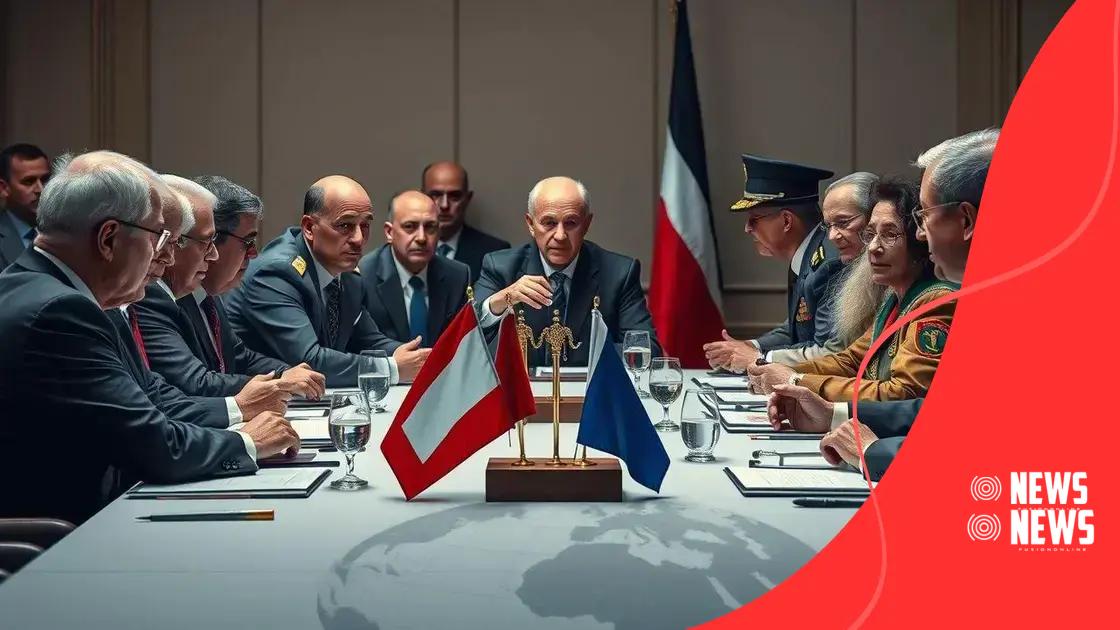International conflict involvement: understanding the dynamics
International conflict involvement refers to how nations engage in conflicts beyond their borders, impacting global relations, humanitarian issues, and economic stability.
International conflict involvement can often feel overwhelming, touching lives across borders. Have you ever wondered how these conflicts shape our world? Let’s dig deeper into the intricate web of alliances, actions, and their impact.
Defining international conflict involvement
Understanding international conflict involvement is crucial to grasp how countries interact on the global stage. This concept refers to how nations engage in conflicts that transcend their borders, affecting global politics, humanitarian issues, and economic stability.
Key Aspects of International Conflict Involvement
Countries become involved in international conflicts for various reasons. Historical ties, economic interests, and political alliances often motivate nations to intervene or support specific sides in conflicts. These motivations can stem from colonial legacies or strategic interests that drive nations to act in ways that align with their national goals.
- Support in conflicts: Nations may involve themselves by providing military support, diplomatic solutions, or financial assistance to particular factions.
- Alliance systems: Many countries engage in international conflicts due to obligations to their allies or as part of larger international organizations like NATO or the UN.
- Humanitarian intervention: Sometimes intervention is justified on moral grounds, particularly when there are widespread human rights abuses.
Moreover, the consequences of international conflict involvement are multi-faceted. They can lead to significant political changes, inspire movements for independence, or create new diplomatic tensions. The outcomes often shape the perception of global powers and influence future relationships between nations.
Impact of Economic Factors
Economic considerations play a vital role in determining how countries engage in international conflicts. For example, access to natural resources can provoke involvement, as nations vie for control over lucrative territories. Additionally, economic sanctions or trade relations can determine a nation’s stance in ongoing conflicts, affecting their military and humanitarian decisions.
International conflict involvement is not just about military might. The interplay of diplomacy and international laws significantly affects how conflicts unfold. Countries often weigh their decisions against potential backlash or support from the international community.
Furthermore, public opinion within the nations involved also shapes their actions. Citizens and advocacy groups may influence leaders to either escalate involvement or seek peaceful resolutions.
Motivations Behind Involvement
Different motivations drive international conflict involvement, encompassing a wide range of strategic, economic, and ideological factors:
- Strategic interests: Governments may act to protect key alliances or interests in specific regions.
- Resource acquisition: The desire to control valuable resources can motivate nations to intervene in conflicts.
- Political ideology: States may back certain factions based on shared ideologies or democratic principles.
Overall, the complexity of international conflict involvement reflects the intricate web of relationships between nations. By understanding these dynamics, we can better appreciate the motivations behind global affairs and the importance of diplomatic efforts in resolving such conflicts.
Historical context of major conflicts
The historical context of major conflicts provides essential insights into today’s international relations. Understanding past wars and disputes can help us recognize patterns and anticipate future conflicts. Each conflict has its unique causes, often rooted in historical events that shaped nations’ borders and identities.
Significant Historical Events
Throughout history, numerous conflicts have altered the landscape of nations. The World Wars significantly reshaped global alliances, leading to new power structures. Additionally, colonial histories often haunt former colonies, influencing their current relations with their former colonizers.
- World War I: Sparked new political ideologies and territorial disputes that set the stage for future conflicts.
- World War II: Led to the establishment of the United Nations, aimed at promoting peace, yet resulted in significant geopolitical shifts.
- The Cold War: Created a divide between East and West, leading to numerous proxy wars around the globe.
These events not only forged alliances but also instilled deep-seated animosities that can still resonate today. After the World Wars, for example, many nations sought to establish a lasting peace through collaborative efforts, yet underlying tensions often resurfaced.
Legacy of Colonialism
Colonialism left lasting scars on many nations. Territories were redrawn without considering ethnic or cultural realities, leading to conflict. The struggles for independence in the 20th century are examples of how the legacy of colonialism continues to influence national identities and international relations.
Moreover, the economic disparities created during colonial times often persist today, fueling further conflicts. Resources extracted from colonized regions still benefit former colonial powers, leaving a legacy of inequality that can incite tensions and resentments. As nations strive for self-determination, these historical grievances shape their interactions on the world stage.
Modern Implications
The historical roots of these conflicts show why understanding the past is essential for addressing modern issues. As nations navigate their relationships, they must reckon with historical grievances while seeking paths toward reconciliation. Many countries are now working to address these legacies through diplomacy and collaboration.
In conclusion, the historical context of major conflicts is a tapestry woven from numerous threads, each representing different narratives and experiences. By learning from history, we can better understand and address the complex issues that continue to affect international relations.
Key players in international conflicts

Identifying the key players in international conflicts is crucial to understanding the dynamics of global relations. These players can include nations, non-state actors, and international organizations, each influencing the outcome of conflicts in different ways. Understanding their roles provides insight into how conflicts unfold and evolve.
Nations as Primary Actors
Countries often take center stage in international conflicts. They can be directly involved in conflicts or support certain factions through military or financial aid. For instance, superpowers like the United States and Russia frequently engage in conflicts across the globe, providing support to allies or intervening directly in wars. National interests such as security, trade, and political influence drive these actions.
- United States: Known for its military involvement and diplomatic efforts in conflicts around the world.
- Russia: Engages in conflicts to expand its influence and protect its borders.
- China: Often involved economically and politically, fostering partnerships that can lead to conflict.
In addition to these superpowers, smaller nations also play significant roles in regional conflicts. Their actions can be driven by historical grievances or strategic interests. For example, conflicts in the Middle East often see smaller nations engaging in proxy wars, reflecting larger geopolitical struggles.
Non-State Actors
Non-state actors such as terrorist organizations and armed groups also play a vital role in international conflicts. These groups can impact conflicts by challenging state authority or by shaping local dynamics. For instance, groups like ISIS and Al-Qaeda have influenced conflicts in the Middle East by creating instability, affecting global security.
Additionally, rebel groups in various countries often fight against established governments. Their motivations can be driven by ethnic, political, or economic grievances, impacting the nature of conflicts significantly. By leveraging local support and resources, they can alter the power dynamics at play.
International Organizations
Organizations like the United Nations (UN), NATO, and the African Union (AU) are also crucial players in managing and resolving conflicts. They often provide platforms for diplomatic dialogue and conflict resolution, deploying peacekeeping forces to stabilize regions.
Through resolutions, negotiations, and sanctions, these organizations work to maintain peace and security. However, their effectiveness can vary based on the political will of member states and the complexity of the conflicts.
The interplay between nation-states, non-state actors, and international organizations shapes the contours of modern international conflicts. Understanding these players is essential for comprehending the broader implications of conflicts on global peace and security.
Consequences of involvement in conflicts
The consequences of involvement in conflicts can be profound and far-reaching, impacting nations, communities, and individuals. When countries engage in wars or support specific sides, the fallout often extends beyond immediate military outcomes, affecting social structures, economies, and international relations.
Humanitarian Impact
One of the most visible consequences of conflict involvement is the humanitarian crisis it can create. Wars often lead to loss of life, displacement of populations, and widespread suffering. Refugees fleeing violence seek safety across borders, creating challenges in host countries.
- Displacement: Millions may be forced to leave their homes, leading to refugee crises.
- Health risks: Conflicts can disrupt healthcare systems, leading to outbreaks of disease.
- Food insecurity: War often results in agricultural disruption, causing starvation and malnutrition.
The international community often faces pressure to respond to these humanitarian crises. Non-governmental organizations (NGOs) frequently work to provide aid, but their efforts can be hampered by ongoing violence.
Economic Consequences
Economically, conflicts can devastate nations involved. The costs of warfare can drain national treasuries, diverting funds from vital social programs. Infrastructure can be destroyed, crippling economies that may take generations to recover.
Additionally, the instability caused by conflicts can deter foreign investment and disrupt trade routes. Countries that are involved in prolonged conflicts may see lasting economic repercussions that affect their growth and stability.
Political Ramifications
Politically, involvement in conflicts can reshape governments and alter alliances. Nations may shift their foreign policies in response to their experiences in conflict, forming new partnerships or facing isolation.
Conflicts can also lead to regime changes. New leaders may emerge, promising peace but sometimes leading to further unrest. Additionally, the rise of extremist groups can occur in the power vacuums left by conflicts, complicating international relations.
As the cycle of conflict continues, addressing these consequences becomes critical. The long-term effects often highlight the need for effective conflict resolution strategies that focus not only on immediate peace but also on rebuilding and reconciliation pathways. The complexities of the consequences of conflict involvement underline the importance of proactive diplomacy and international cooperation.
Strategies for conflict resolution
Strategies for conflict resolution are essential for establishing lasting peace and preventing the recurrence of violence. Effective resolutions can transform hostile situations into opportunities for cooperation and understanding. Various approaches exist that countries and organizations can utilize to address conflicts constructively.
Negotiation and Mediation
One of the primary methods of conflict resolution is through negotiation and mediation. In this process, parties work together to find mutually acceptable solutions. Mediators, often neutral third parties, can facilitate discussions to help conflicting sides reach agreements.
- Direct negotiation: Involves the conflicting parties discussing their issues openly to find common ground.
- Mediation: A mediator assists the parties in communication, ensuring all voices are heard.
- Collaborative problem-solving: Focuses on understanding each party’s interests to develop solutions that satisfy everyone.
Successful negotiation can lead to formal agreements, such as treaties or ceasefires, setting the stage for rebuilding relationships.
Peacekeeping Forces
Another strategy involves deploying peacekeeping forces to conflict zones. These forces, often led by international organizations like the United Nations, aim to maintain peace and prevent further violence. Their presence can help create a secure environment for negotiations.
Peacekeepers monitor ceasefires, protect civilians, and assist in humanitarian efforts, making it safer for dialogues to take place.
Building Trust and Reconciliation
Trust-building measures are crucial in resolving conflicts. Initiatives that promote understanding between rival groups can diminish hostilities. Programs may include community dialogue, cultural exchanges, and joint projects.
Additionally, addressing historical grievances and acknowledging past injustices can lay the groundwork for reconciliation. In many cases, truth commissions are established to ensure accountability and foster healing.
International Diplomacy
Engaging in international diplomacy can also provide pathways to conflict resolution. Countries often work together through diplomatic channels to manage disputes before they escalate into violence. Forums like the United Nations and regional organizations play pivotal roles in mediating discussions.
Through diplomatic pressure, sanctions, or incentives, nations can work collaboratively to achieve peace. The involvement of multiple actors can increase the credibility of peace processes and bolster the chances for successful resolutions.
Strategies for conflict resolution require patience and persistence. While approaches may vary based on the specific context, the ultimate goal is to create a sustainable framework for peace that addresses the underlying causes of conflict and promotes long-term stability.
In summary, understanding international conflict involvement is crucial for promoting peace and stability in the world. By examining the key players and their motivations, we can develop effective strategies for conflict resolution. Addressing the humanitarian and economic consequences is vital for rebuilding communities and creating lasting solutions. Finally, fostering diplomacy and engagement among nations can pave the way for a more peaceful future. Through collaboration and commitment to dialogue, we can work together to prevent conflicts and build bridges across divides.
FAQ – Frequently Asked Questions about International Conflict Involvement
What are the main reasons countries get involved in international conflicts?
Countries often get involved in international conflicts due to national interests, historical ties, economic benefits, or humanitarian concerns.
How do humanitarian crises arise from conflicts?
Conflict involvement frequently leads to humanitarian crises, including loss of life, displacement of populations, and disruption of essential services like healthcare and food supply.
What strategies can be used for conflict resolution?
Strategies like negotiation, mediation, peacekeeping operations, and diplomatic efforts are essential for resolving conflicts and promoting lasting peace.
What are the consequences of involvement in conflicts?
Consequences can include economic instability, social upheaval, increased violence, and ongoing humanitarian issues affecting both the involved nations and the global community.





